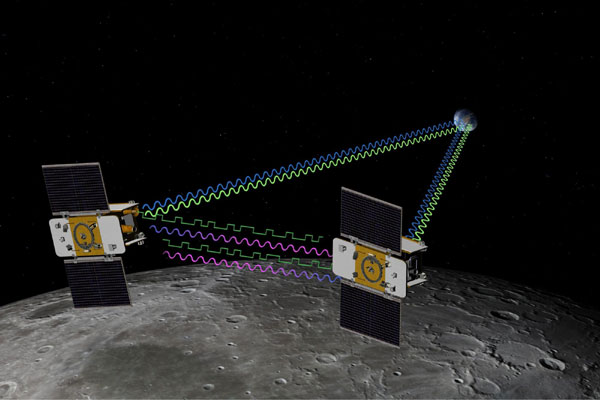NASA moon-mapping mission to come to a crashing end
Updated: 2012-12-14 10:28
(Agencies)
|
||||||||
 |
|
NASA handout image shows an artist's concept of the Gravity Recovery and Interior Laboratory (GRAIL) mission's twin spacecraft in orbit around the moon. The GRAIL mission will fly the spacecraft, in the same orbit, over areas of greater and lesser gravity, caused both by visible features such as mountains and craters and by masses hidden beneath the lunar surface, they will move slightly toward and away from each other. The twin GRAIL spacecraft will make suicidal plunges Dec 17, 2012 into a mountain near the moon's north pole,after a successful year-long mission to learn what lies beneath the lunar surface, officials said on Dec 13.[Photo/Agencies] |
CAPE CANAVERAL, Fla - NASA plans to crash a pair of small robotic science probes into the moon next week after a successful year-long mission to learn what lies beneath the lunar surface, officials said on Thursday.
The twin Gravity Recovery and Interior Laboratory, or GRAIL, spacecraft will make suicidal plunges on Monday into a mountain near the moon's north pole, a site selected to avoid the chance of hitting any of the Apollo or other lunar relics.
The impacts, which are not expected to be visible from Earth, will take place about 20 seconds apart at 5:28 pm EST (2228 GMT) on Monday.
"They're going to be completely blown apart," GRAIL project manager David Lehman, with NASA's Jet Propulsion Laboratory in Pasadena, California, told reporters on a conference call.
Almost out of fuel and currently flying just 7 miles (11 km) above the lunar surface, the probes will make a final steering maneuver on Friday and shut down their science instruments in preparation for Monday's crash.
The two spacecraft, each about the size of a small washing machine, have been flying in close formation around the moon for nearly a year to map the lunar gravity.
Scientists precisely measure the distance between the two, a figure that slightly changes as they fly over denser regions of the moon. The gravitational pull of the additional mass causes first the leading probe and then the following one to speed up, altering the gap between them.
Gravity maps from the first part of the mission, collected between March and May 2012 when the spacecraft were about 34 miles (55 km) above the lunar surface, revealed the moon has a shallower and much more fractured crust than expected - the result of asteroid and comet impacts billions of years ago.
"We know that the moon had been bombarded by impacts but what we found is just how broken up and fractured the crust of the moon is," said lead scientist Maria Zuber, with the Massachusetts Institute of Technology.
Similar bombardments happened on all the solid bodies of the inner solar system though the evidence on Earth has been erased by erosion, plate tectonics and other phenomena.
"With Mars, there's a questions about where did the water that we think was on the surface go," Zuber said. "These fractures provide a pathway deep inside the planet and it's very easy to envision now how a possible ocean on the surface could have found its way deep into the crust."
Scientists also discovered lava-filled subterranean cracks inside the moon, evidence that the body expanded early in its history.
In addition to planetary science, the gravity maps, along with detailed images of the lunar surface, should help engineers pick landing sites for future robotic and human expeditions to the moon, Zuber said.
"In my wildest dreams, I could not have imagined that this mission would have gone any better than it has," she said, adding that NASA will be getting $8 million or $9 million back from the mission's $471 million budget.
The spacecraft will hit the surface at about 3,760 miles per hour (6,120 kph). No pictures are expected because the region will be dark at the time of impact, but a sister spacecraft circling the moon, NASA's Lunar Reconnaissance Orbiter, will attempt to survey the crash site.
"These are two small spacecraft with empty fuel tanks, so we're not expecting a flash that is visible from Earth," Zuber said.

 Relief reaches isolated village
Relief reaches isolated village
 Rainfall poses new threats to quake-hit region
Rainfall poses new threats to quake-hit region
 Funerals begin for Boston bombing victims
Funerals begin for Boston bombing victims
 Quake takeaway from China's Air Force
Quake takeaway from China's Air Force
 Obama celebrates young inventors at science fair
Obama celebrates young inventors at science fair
 Earth Day marked around the world
Earth Day marked around the world
 Volunteer team helping students find sense of normalcy
Volunteer team helping students find sense of normalcy
 Ethnic groups quick to join rescue efforts
Ethnic groups quick to join rescue efforts
Most Viewed
Editor's Picks

|

|

|

|

|

|
Today's Top News
Health new priority for quake zone
Xi meets US top military officer
Japan's boats driven out of Diaoyu
China mulls online shopping legislation
Bird flu death toll rises to 22
Putin appoints new ambassador to China
Japanese ships blocked from Diaoyu Islands
Inspired by Guan, more Chinese pick up golf
US Weekly

|

|






